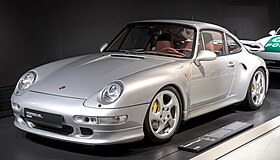| Porsche 993 | |
|---|---|
 Porsche 993 Turbo S | |
| Overview | |
| Manufacturer | Porsche |
| Also called | Porsche 911 Porsche Carrera |
| Production | January 1994–1998[1] |
| Assembly | Germany: Stuttgart, Zuffenhausen |
| Designer | Tony Hatter (1991)[2] |
| Body and chassis | |
| Class | Sports car (S) |
| Body style |
|
| Layout | Rear-engine, rear-wheel-drive/rear-engine, all-wheel drive |
| Related | |
| Powertrain | |
| Engine |
|
| Transmission | |
| Dimensions | |
| Wheelbase | 89.45 in (2,272 mm) |
| Length | 167.7 in (4,260 mm) |
| Width |
|
| Height |
|
| Curb weight | Base Coupé: 3,064 lb (1,390 kg) |
| Chronology | |
| Predecessor | Porsche 964 |
| Successor | Porsche 996 Porsche 911 GT3 (for 911 Carrera RS) |
The Porsche 993 is the fourth generation of the Porsche 911 model sports car manufactured and sold between January 1994 and early 1998 (model years 1995–1998 in the United States), replacing the 964. Its discontinuation marked the end of air-cooled 911 models.
The 993 was much improved over and quite different from its predecessor. According to Porsche, every part of the car was designed from the ground up, including the engine[3] and only 20% of its parts were carried over from the previous generation.[4] Porsche refers to the 993 as "a significant advance, not just from a technical, but also a visual perspective."[5] Porsche's engineers devised a new light-alloy subframe with coil and wishbone suspension (an all new multi-link system, Weissach axle), putting behind the previous lift-off oversteer[3] and making significant progress with the engine and handling, creating a more civilized car overall and providing an improved driving experience.[4] The 993 was also the first 911 to receive a six speed transmission.[6]
The 993 had several variants, as its predecessors, varying in body style, engines, drivetrains, and included equipment. Power was increased by the addition of the VarioRam system, particularly in the midranges, and also resulted in more throttle noise at higher revolutions; as a consequence, it resulted in a 15 percent increase in power over its predecessor.[7]
The external design of the Porsche 993 was penned by English designer Tony Hatter and retained the basic body shell architecture of the 964 and other earlier 911 models, but with revised exterior panels with much more flared wheel arches, a smoother front and rear bumper design, an enlarged retractable rear wing, and teardrop mirrors.
A 993 GT2 was used as the safety car during the 1995 Formula One season.[8]
- ^ Paternie, Patrick; Bodensteiner, Peter (8 June 2015). Porsche 911 Red Book 3rd Edition: Specifications, Options, Production Numbers, Data Codes and More. Motorbooks. ISBN 9780760347607.
- ^ Panait, Mircea (March 2015). "This Porsche 993 GT2 is the Last of the Great Air-Cooled Turbocharged 911s – Photo Gallery". autoevolution.
- ^ a b AutoTraderClassics.com — Article Finding Porsche's best road car — Porsche 911S vs 993.
- ^ a b "Porsche 993 Carrera 2S".
- ^ http://www.porsche.com/international/accessoriesand service/classic/models/999/993/.
- ^ http://www.stuttcars.com/porsche-models/911/993. Archived 23 October 2015 at the Wayback Machine
- ^ http://www.porsche.com/usa/accessoriesand services/classic/models/993/993/
- ^ "The CAR Top 10: F1 safety cars". Car. 3 April 2015. Retrieved 29 October 2019.